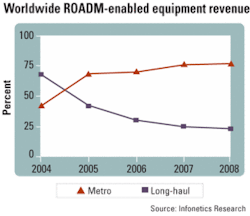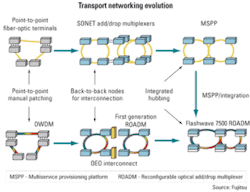Timing right for ROADMs?
“There’s been lots of talk and lots of interest in ROADM and metro WDM technology, but it was never quite the glorious thing that people were anticipating,” admits Sam Lisle, director of market development at Fujitsu Network Communications (Richardson, TX). To date, ROADMs mostly have been used in point-to-point, fiber relief-type applications, he says, “the non-glamorous, blue-collar kind of deployments.” But this may be about to change, thanks to a slew of vendor announcements and a surprisingly active 2004.
Last year proved to be a big year for ROADMs. SuperComm 2004 served as a ROADM coming out party of sorts, with more than half a dozen vendors debuting ROADM equipment. There was no shortage of contract announcements either, mostly in the long-haul segment. Marconi inked deals with British Telecom and Telecom Italia. Fujitsu, the worldwide leader in ROADM deployments according to both RHK (San Francisco) and Infonetics Research (San Jose, CA), sold ROADM equipment to NTT and others in Japan and saw great success in the U.S. cable multiple-systems-operator (MSO) market. Lucent Technologies and Siemens were also active, and Cisco Systems reportedly had orders for 100 ROADM systems by the end of last year.
“I was totally shocked at the amount of equipment that had already been deployed in 2004,” says Michael Howard, principal analyst and co-founder of Infonetics Research, which recently published a ROADM report. “We counted ROADM-enabled equipment, meaning WDM equipment that had ROADM equipment inside when it was sold, not just the ROADM blades. Well over $100 million worth of WDM ROADM gear was sold into the long-haul and metro in 2004, and we think that will double in 2005.”
So why all the interest in ROADMs now? According to Lisle, U.S. carriers need to make significant investments in new services networks to compete head-to-head with the cable MSOs-something they have not been forced to do in the past.
“Billions of dollars are being spent on fiber to the wherever you can make money,” reports Lisle. “They’ve built IP/MPLS backbones in the metro. They’ve spent a lot of money there on carrier class routers for IP VPN [virtual-private-network] services and on optical Ethernet networks for enterprise data services. They are also investing in packet voice. The fact that the ILECs are making significant investments in these areas is going to create the same type of spending dynamic and network transformation that occurred with the MSOs a couple of years ago.”The metro core backbone will be more diverse geographically than it was before, and it will support a higher volume of bandwidth, with an emphasis on Gigabit Ethernet (GbE) and high-speed OC-n-type traffic. Long-term, says Lisle, traditional technologies will prove insufficient and hinder the carriers’ competitiveness. “They are going to need something like a ROADM,” he contends, “because there’s more uncertainty as to the traffic patterns on those types of services. You want an infrastructure you can adapt and shift, even if you don’t exactly know the volume and the nature of the demand.”
Jeff Maddox, senior manager of product-line management for DWDM products in Optical Networking Group of Cisco (San Jose), does not question the sudden popularity of ROADMs. “The more critical question is why are people migrating more quickly today to DWDM than they might have been in the past?” he reasons. In his mind, the answer has to do with the industry’s convergence on IP-based traffic and Ethernet in particular. SONET and TDM were designed around telephone circuits, he explains, and GbE and 10-GbE do not fit well inside an OC-n or STS types of envelope. “One of the things we are starting to see is that ROADM has lowered the barrier to operational challenge, and the GbE traffic growth or Ethernet packet traffic growth that’s driven by broadband access or video on demand types of service applications, that is driving people to use WDM as a core transport mechanism across a lot of segments,” he reports. “The role of ROADM will really be the core transport technology, replacing to some extent the role of what SONET has done for telephony in the past.”
ROADMs provide three basic functions: They act as wavelength switches, enable a single wavelength or any number of wavelengths to be added or dropped at each node, and provide automatic power monitoring and management, eliminating the need for manual intervention to adjust the power level for each wavelength. These capabilities are critical, says Howard, because “carriers now have the ability to think about the WDM layer as the basic transport layer rather than SONET. It’s easily managed and it’s easily deployed. The wavelengths are easily provisioned and deprovisioned all while sitting in the NOC [network operations center]. I think [ROADM] is going to increase the sales of WDM. And in fact, it already is.”
Not everyone is quite so bullish on ROADMs, however. The folks at ADVA Optical Networking (Munich, Germany, and Mahwah, NJ) believe that ROADM capability will flourish in the future, but it is not necessary today and may not be necessary for all applications going forward. “Traffic patterns and the degree to which you can predict [those patterns] determine how much value a ROADM brings you,” contends ADVA business development director Per Hanson.
Consider a linear network that stretches from New York City to San Francisco as an example. Traffic comes into the network at one end and leaves at the other end. “For that you don’t need any reconfigurability,” says Hanson. “What you may want to do actually is nail up kind of a highway from one end to the other to carry that traffic, to get the most bandwidth for the least investment.”
Now consider a ring network around a metro area. In this case, traffic patterns are less predictable, says Hanson. “Because there are many equal nodes and two ways of getting to each one of them, that gives you more unpredictability. I think this is a topic that service providers may not have taken enough advantage of yet-to try to look at what is the traffic in a network like this and how much do they know about it? With how high a degree of certainty can you predict where it’s coming from? I think you can reduce your capital expenses by considering that.”
According to Hanson, using a ROADM for any node to any node connectivity also significantly affects the engineering rules of the network. Any connection incurs loss and requires some amount of amplification and dispersion compensation, he says. If you know where your connection is going, you can install the minimum supporting equipment necessary to ensure high-quality transmission between two sites.“But if you don’t know or you want to have the freedom to connect any node to any node, you need to cover the best case and the worst case and all the cases in between,” he explains. That translates into a need for more amplifiers and more dispersion compensation modules (DCMs). Moreover, ROADMs typically exhibit higher losses than static filters, so the devices themselves require additional compensation.
“An interesting point that many gloss over is the fact that the added cost is not just the cost of those ROADMs, but it’s also the cost of those amplifiers and DCMs to support this any node to any node connectivity,” he asserts, “and that cost is not insignificant.”
Even the ability to eliminate truck rolls through remote provisioning-which Hanson believes may be the least important of all ROADM benefits-is a bit misleading, he says. “It’s worth noting that even in those cases, you still need to go out to the egress and ingress points on the network,” he maintains. “Client equipment, at least, would not be connected until the customer says, ‘I want this equipment connected via your network.’ So you always need some manual intervention at those two points.”
For his part, Howard believes ADVA knows what it’s doing. The company has assessed its market and its customers, and it will come out with ROADM functionality only when it feels its customers need that functionality, he notes. “They didn’t participate in this $100-million market last year, of which over half was long-haul, because they don’t play in that part,” he says. “But if you look at Cisco, Fujitsu, and Opvista, there is quite a bit of revenue there that is a real market.”
Eventually, every WDM vendor will include ROADM capabilities in its product set, says Howard. “By 2007, about 46% of metro WDM revenues will include ROADMs. Right now, it looks like a new technology, a new box, a new function,” he says. “Yes, it is, but it’s a natural progression of what’s been going to happen for a long time. We believe [ROADM] is not going to be something special four years from now.”
The folks at Cisco report that even their enterprise customers are entertaining the use of ROADM technology. “There is no one specific customer segment that is using [ROADM technology] more readily than another,” says Maddox. But even in the access?
“That’s a surprising one,” admits Howard. “They would have to be big enterprise customers to want a ROADM.”
Glenn Thurston, vice president of marketing at metro edge systems supplier BTI Photonic Systems (Ottawa, Ontario), believes the current generation of module technology-at around $10,000 per module-is still one or two orders of magnitude too expensive for the edge, which today doesn’t require reconfigurability. “In our space at the edge, our ROADM is a guy with a hardhat and a piece of fiber,” he says. “And he can do a function chance for about $5.”
That said, Thurston recognizes that by the time third generation ROADM technology becomes available, modules should be priced in the $500-$3,000 range, “and then it starts to get interesting,” he adds. “A couple of years out, the edge is going to be a lot more built-out with services, and there will start being a requirement, so we absolutely see [ROADM technology] out there at the edge. The technology is going to mature. Prices are going to come down. The services pull is going to happen, and then there is a place for the technology.”


